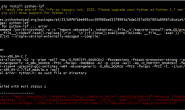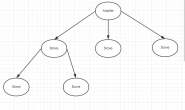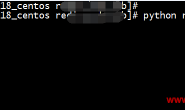前面的一篇文件中简单的介绍了一下Redis,并且安装了一个单实例的Redis 4.0的环境,不管怎么说,有了环境,学习起来还是相对的方便的;
关于CentOS 7安装Redis 4.0版本详细可参考:CentOS 7安装redis 4.0详细步骤
在启动Redis服务的时候,我们指定了一个配置文件,那么具体配置文件中的一些参数都是干什么的呢?我下面来简单说明一下;
一、Redis的介绍补充
Redis是一个key-value存储系统。和Memcached类似,它支持存储的value类型相对更多,包括string(字符串)、 list(链表)、set(集合)、zset(sorted set –有序集合)和hash(哈希类型)。这些数据类型都支持push/pop、add/remove及取交集并集和差集及更丰富的操作,而且这些操作都是原 子性的。在此基础上,redis支持各种不同方式的排序。与memcached一样,为了保证效率,数据都是缓存在内存中。区别的是redis会周期性的 把更新的数据写入磁盘或者把修改操作写入追加的记录文件,并且在此基础上实现了master-slave(主从)同步。
先简单说说redi和mysql的一些区别:
redis和mysql要根据具体业务场景去选型
mysql:数据放在磁盘 redis:数据放在内存
redis适合放一些频繁使用,比较热的数据,因为是放在内存中,读写速度都非常快
首先要知道mysql存储在磁盘里,redis存储在内存里,redis既可以用来做持久存储,也可以做缓存,而目前大多数公司的存储都是mysql + redis,其中:mysql作为主存储,redis作为辅助存储被用作缓存,加快访问读取的速度,提高性能。
那么为什么不直接全部用redis存储呢?
因为redis存储在内存中,如果存储在内存中,存储容量肯定要比磁盘少很多,那么要存储大量数据,只能花更多的钱去购买内存,造成在一些不需要高性能的地方是相对比较浪费的,所以目前基本都是mysql(主) + redis(辅),在需要性能的地方使用redis,在不需要高性能的地方使用mysql,好钢用在刀刃上
1)mysql支持sql查询,可以实现一些关联的查询以及统计;
2)redis对内存要求比较高,在有限的条件下不能把所有数据都放在redis;
3)mysql偏向于存数据,redis偏向于快速取数据,但redis查询复杂的表关系时不如mysql,所以可以把热门的数据放redis,mysql存基本数据
二、redis.conf配置详细解析
# redis 配置文件示例
# 当你需要为某个配置项指定内存大小的时候,必须要带上单位,
# 通常的格式就是 1k 5gb 4m 等酱紫:
#
# 1k => 1000 bytes
# 1kb => 1024 bytes
# 1m => 1000000 bytes
# 1mb => 1024*1024 bytes
# 1g => 1000000000 bytes
# 1gb => 1024*1024*1024 bytes
#
# 单位是不区分大小写的,你写 1K 5GB 4M 也行################################## INCLUDES ###################################
# 假如说你有一个可用于所有的 redis server 的标准配置模板,
# 但针对某些 server 又需要一些个性化的设置,
# 你可以使用 include 来包含一些其他的配置文件,这对你来说是非常有用的。
#
# 但是要注意哦,include 是不能被 config rewrite 命令改写的
# 由于 redis 总是以最后作为一个配置指令值,所以你最好是把 include 放在这个文件的最前面,
# 以避免在运行时覆盖配置的改变,相反,你就把它放在后面。
#
# include /path/to/local.conf
# include /path/to/other.conf
################################ 常用 #####################################
# 默认情况下 redis 不是作为守护进程运行的,如果你想让它在后台运行,你就把它改成 yes。
# 当redis作为守护进程运行的时候,它会写一个 pid 到 /var/run/redis.pid 文件里面。
daemonize no# 当redis作为守护进程运行的时候,它会把 pid 默认写到 /var/run/redis.pid 文件里面,
# 但是你可以在这里自己制定它的文件位置。
pidfile /var/run/redis.pid# 监听端口号,默认为 6379,如果你设为 0 ,redis 将不在 socket 上监听任何客户端连接。
port 6379# TCP 监听的最大容纳数量
#
# 在高并发的环境下,你需要把这个值调高以避免客户端连接缓慢的问题。
# Linux 内核会一声不响的把这个值缩小成 /proc/sys/net/core/somaxconn 对应的值,
# 所以你要修改这两个值才能达到你的预期。
tcp-backlog 511# 默认情况下,redis 在 server 上所有有效的网络接口上监听客户端连接。
# 你如果只想让它在一个网络接口上监听,那你就绑定一个IP或者多个IP。
#
# 示例,多个IP用空格隔开:
#
# bind 192.168.1.100 10.0.0.1
# bind 127.0.0.1
# 指定 unix socket 的路径。
#
# unixsocket /tmp/redis.sock
# unixsocketperm 755
# 指定在一个 client 空闲多少秒之后关闭连接(0 就是不管它)
timeout 0# tcp 心跳包。
#
# 如果设置为非零,则在与客户端缺乏通讯的时候使用 SO_KEEPALIVE 发送 tcp acks 给客户端。
# 这个之所有有用,主要由两个原因:
#
# 1) 防止死的 peers
# 2) Take the connection alive from the point of view of network
# equipment in the middle.
#
# On Linux, the specified value (in seconds) is the period used to send ACKs.
# Note that to close the connection the double of the time is needed.
# On other kernels the period depends on the kernel configuration.
#
# A reasonable value for this option is 60 seconds.
# 推荐一个合理的值就是60秒
tcp-keepalive 0# 定义日志级别。
# 可以是下面的这些值:
# debug (适用于开发或测试阶段)
# verbose (many rarely useful info, but not a mess like the debug level)
# notice (适用于生产环境)
# warning (仅仅一些重要的消息被记录)loglevel notice
# 指定日志文件的位置
logfile “”# 要想把日志记录到系统日志,就把它改成 yes,
# 也可以可选择性的更新其他的syslog 参数以达到你的要求
# syslog-enabled no
# 设置 syslog 的 identity。
# syslog-ident redis
# 设置 syslog 的 facility,必须是 USER 或者是 LOCAL0-LOCAL7 之间的值。
# syslog-facility local0
# 设置数据库的数目。
# 默认数据库是 DB 0,你可以在每个连接上使用 select 命令选择一个不同的数据库,
# 但是 dbid 必须是一个介于 0 到 databasees – 1 之间的值
databases 16################################ 快照 ################################
#
# 存 DB 到磁盘:
#
# 格式:save <间隔时间(秒)> <写入次数>
#
# 根据给定的时间间隔和写入次数将数据保存到磁盘
#
# 下面的例子的意思是:
# 900 秒内如果至少有 1 个 key 的值变化,则保存
# 300 秒内如果至少有 10 个 key 的值变化,则保存
# 60 秒内如果至少有 10000 个 key 的值变化,则保存
#
# 注意:你可以注释掉所有的 save 行来停用保存功能。
# 也可以直接一个空字符串来实现停用:
# save “”
save 900 1
save 300 10
save 60 10000# 默认情况下,如果 redis 最后一次的后台保存失败,redis 将停止接受写操作,
# 这样以一种强硬的方式让用户知道数据不能正确的持久化到磁盘,
# 否则就会没人注意到灾难的发生。
#
# 如果后台保存进程重新启动工作了,redis 也将自动的允许写操作。
#
# 然而你要是安装了靠谱的监控,你可能不希望 redis 这样做,那你就改成 no 好了。
stop-writes-on-bgsave-error yes# 是否在 dump .rdb 数据库的时候使用 LZF 压缩字符串
# 默认都设为 yes
# 如果你希望保存子进程节省点 cpu ,你就设置它为 no ,
# 不过这个数据集可能就会比较大rdbcompression yes
# 是否校验rdb文件rdbchecksum yes
# 设置 dump 的文件位置dbfilename dump.rdb
# 工作目录
# 例如上面的 dbfilename 只指定了文件名,
# 但是它会写入到这个目录下。这个配置项一定是个目录,而不能是文件名。
dir ./################################# 主从复制 #################################
# 主从复制。使用 slaveof 来让一个 redis 实例成为另一个reids 实例的副本。
# 注意这个只需要在 slave 上配置。
#
# slaveof
# 如果 master 需要密码认证,就在这里设置
# masterauth
# 当一个 slave 与 master 失去联系,或者复制正在进行的时候,
# slave 可能会有两种表现:
#
# 1) 如果为 yes ,slave 仍然会应答客户端请求,但返回的数据可能是过时,
# 或者数据可能是空的在第一次同步的时候
#
# 2) 如果为 no ,在你执行除了 info he salveof 之外的其他命令时,
# slave 都将返回一个 “SYNC with master in progress” 的错误,
#slave-serve-stale-data yes# 你可以配置一个 slave 实体是否接受写入操作。
# 通过写入操作来存储一些短暂的数据对于一个 slave 实例来说可能是有用的,
# 因为相对从 master 重新同步数而言,据数据写入到 slave 会更容易被删除。
# 但是如果客户端因为一个错误的配置写入,也可能会导致一些问题。
#
# 从 redis 2.6 版起,默认 slaves 都是只读的。
#
# Note: read only slaves are not designed to be exposed to untrusted clients
# on the internet. It’s just a protection layer against misuse of the instance.
# Still a read only slave exports by default all the administrative commands
# such as CONFIG, DEBUG, and so forth. To a limited extent you can improve
# security of read only slaves using ‘rename-command’ to shadow all the
# administrative / dangerous commands.
# 注意:只读的 slaves 没有被设计成在 internet 上暴露给不受信任的客户端。
# 它仅仅是一个针对误用实例的一个保护层。
slave-read-only yes# Slaves 在一个预定义的时间间隔内发送 ping 命令到 server 。
# 你可以改变这个时间间隔。默认为 10 秒。
#
# repl-ping-slave-period 10
# The following option sets the replication timeout for:
# 设置主从复制过期时间
#
# 1) Bulk transfer I/O during SYNC, from the point of view of slave.
# 2) Master timeout from the point of view of slaves (data, pings).
# 3) Slave timeout from the point of view of masters (REPLCONF ACK pings).
#
# It is important to make sure that this value is greater than the value
# specified for repl-ping-slave-period otherwise a timeout will be detected
# every time there is low traffic between the master and the slave.
# 这个值一定要比 repl-ping-slave-period 大
#
# repl-timeout 60
# Disable TCP_NODELAY on the slave socket after SYNC?
#
# If you select “yes” Redis will use a smaller number of TCP packets and
# less bandwidth to send data to slaves. But this can add a delay for
# the data to appear on the slave side, up to 40 milliseconds with
# Linux kernels using a default configuration.
#
# If you select “no” the delay for data to appear on the slave side will
# be reduced but more bandwidth will be used for replication.
#
# By default we optimize for low latency, but in very high traffic conditions
# or when the master and slaves are many hops away, turning this to “yes” may
# be a good idea.
repl-disable-tcp-nodelay no# 设置主从复制容量大小。这个 backlog 是一个用来在 slaves 被断开连接时
# 存放 slave 数据的 buffer,所以当一个 slave 想要重新连接,通常不希望全部重新同步,
# 只是部分同步就够了,仅仅传递 slave 在断开连接时丢失的这部分数据。
#
# The biggest the replication backlog, the longer the time the slave can be
# disconnected and later be able to perform a partial resynchronization.
# 这个值越大,salve 可以断开连接的时间就越长。
#
# The backlog is only allocated once there is at least a slave connected.
#
# repl-backlog-size 1mb
# After a master has no longer connected slaves for some time, the backlog
# will be freed. The following option configures the amount of seconds that
# need to elapse, starting from the time the last slave disconnected, for
# the backlog buffer to be freed.
# 在某些时候,master 不再连接 slaves,backlog 将被释放。
#
# A value of 0 means to never release the backlog.
# 如果设置为 0 ,意味着绝不释放 backlog 。
#
# repl-backlog-ttl 3600
# 当 master 不能正常工作的时候,Redis Sentinel 会从 slaves 中选出一个新的 master,
# 这个值越小,就越会被优先选中,但是如果是 0 , 那是意味着这个 slave 不可能被选中。
#
# 默认优先级为 100。
slave-priority 100# It is possible for a master to stop accepting writes if there are less than
# N slaves connected, having a lag less or equal than M seconds.
#
# The N slaves need to be in “online” state.
#
# The lag in seconds, that must be <= the specified value, is calculated from
# the last ping received from the slave, that is usually sent every second.
#
# This option does not GUARANTEES that N replicas will accept the write, but
# will limit the window of exposure for lost writes in case not enough slaves
# are available, to the specified number of seconds.
#
# For example to require at least 3 slaves with a lag <= 10 seconds use:
#
# min-slaves-to-write 3
# min-slaves-max-lag 10
#
# Setting one or the other to 0 disables the feature.
#
# By default min-slaves-to-write is set to 0 (feature disabled) and
# min-slaves-max-lag is set to 10.
################################## 安全 ###################################
# Require clients to issue AUTH before processing any other
# commands. This might be useful in environments in which you do not trust
# others with access to the host running redis-server.
#
# This should stay commented out for backward compatibility and because most
# people do not need auth (e.g. they run their own servers).
#
# Warning: since Redis is pretty fast an outside user can try up to
# 150k passwords per second against a good box. This means that you should
# use a very strong password otherwise it will be very easy to break.
#
# 设置认证密码
# requirepass foobared#命令重命名,有时候针对一些高危的命令我们会对其重新命名或禁用高危命令
# Command renaming.
#
# It is possible to change the name of dangerous commands in a shared
# environment. For instance the CONFIG command may be renamed into something
# hard to guess so that it will still be available for internal-use tools
# but not available for general clients.
#
# Example:
#
# rename-command CONFIG b840fc02d524045429941cc15f59e41cb7be6c52
#
# It is also possible to completely kill a command by renaming it into
# an empty string:
#
# rename-command CONFIG “”
#
# Please note that changing the name of commands that are logged into the
# AOF file or transmitted to slaves may cause problems.################################### 限制 ####################################
# Set the max number of connected clients at the same time. By default
# this limit is set to 10000 clients, however if the Redis server is not
# able to configure the process file limit to allow for the specified limit
# the max number of allowed clients is set to the current file limit
# minus 32 (as Redis reserves a few file descriptors for internal uses).
# 同一时间内最大clients连接的数量,超过数量的连接会返回一个错误信息
# 一旦达到最大限制,redis 将关闭所有的新连接
# 并发送一个‘max number of clients reached’的错误。
#
# maxclients 10000
# 如果你设置了这个值,当缓存的数据容量达到这个值, redis 将根据你选择的
# eviction 策略来移除一些 keys。
#
# 如果 redis 不能根据策略移除 keys ,或者是策略被设置为 ‘noeviction’,
# redis 将开始响应错误给命令,如 set,lpush 等等,
# 并继续响应只读的命令,如 get
#
# This option is usually useful when using Redis as an LRU cache, or to set
# a hard memory limit for an instance (using the ‘noeviction’ policy).
#
# WARNING: If you have slaves attached to an instance with maxmemory on,
# the size of the output buffers needed to feed the slaves are subtracted
# from the used memory count, so that network problems / resyncs will
# not trigger a loop where keys are evicted, and in turn the output
# buffer of slaves is full with DELs of keys evicted triggering the deletion
# of more keys, and so forth until the database is completely emptied.
#
# In short… if you have slaves attached it is suggested that you set a lower
# limit for maxmemory so that there is some free RAM on the system for slave
# output buffers (but this is not needed if the policy is ‘noeviction’).
#
# 最大使用内存
# maxmemory
# 最大内存策略,你有 5 个选择。
#
# volatile-lru -> remove the key with an expire set using an LRU algorithm
# volatile-lru -> 使用 LRU 算法移除包含过期设置的 key 。
# allkeys-lru -> remove any key accordingly to the LRU algorithm
# allkeys-lru -> 根据 LRU 算法移除所有的 key 。
# volatile-random -> remove a random key with an expire set
# allkeys-random -> remove a random key, any key
# volatile-ttl -> remove the key with the nearest expire time (minor TTL)
# noeviction -> don’t expire at all, just return an error on write operations
# noeviction -> 不让任何 key 过期,只是给写入操作返回一个错误
#
# Note: with any of the above policies, Redis will return an error on write
# operations, when there are not suitable keys for eviction.
#
# At the date of writing this commands are: set setnx setex append
# incr decr rpush lpush rpushx lpushx linsert lset rpoplpush sadd
# sinter sinterstore sunion sunionstore sdiff sdiffstore zadd zincrby
# zunionstore zinterstore hset hsetnx hmset hincrby incrby decrby
# getset mset msetnx exec sort
#
# The default is:
#
# maxmemory-policy noeviction
# LRU and minimal TTL algorithms are not precise algorithms but approximated
# algorithms (in order to save memory), so you can tune it for speed or
# accuracy. For default Redis will check five keys and pick the one that was
# used less recently, you can change the sample size using the following
# configuration directive.
#
# The default of 5 produces good enough results. 10 Approximates very closely
# true LRU but costs a bit more CPU. 3 is very fast but not very accurate.
# Redis中的LRU不是严格意义上的LRU算法实现,是一种近似的LRU实现,主要是为了节约内存占用以及提升性能。
# Redis的LRU是取出配置的数目的key,然后从中选择一个最近最不经常使用的key进行置换,maxmemory-samples默认的5
# 可以通过调整样本数量来取得LRU置换算法的速度或是精确性方面的优势。
# Redis不采用真正的LRU实现的原因是为了节约内存使用。虽然不是真正的LRU实现,但是它们在应用上几乎是等价的
# 如果你将maxmemory-samples设置为10,那么Redis将会增加额外的CPU开销以保证接近真正的LRU性能,可以通过检查命中率来查看有什么不同。
# maxmemory-samples 5############################## APPEND ONLY MODE ###############################
# By default Redis asynchronously dumps the dataset on disk. This mode is
# good enough in many applications, but an issue with the Redis process or
# a power outage may result into a few minutes of writes lost (depending on
# the configured save points).
#
# The Append Only File is an alternative persistence mode that provides
# much better durability. For instance using the default data fsync policy
# (see later in the config file) Redis can lose just one second of writes in a
# dramatic event like a server power outage, or a single write if something
# wrong with the Redis process itself happens, but the operating system is
# still running correctly.
#
# AOF and RDB persistence can be enabled at the same time without problems.
# If the AOF is enabled on startup Redis will load the AOF, that is the file
# with the better durability guarantees.
#
# Please check http://redis.io/topics/persistence for more information.
appendonly no# The name of the append only file (default: “appendonly.aof”)
appendfilename “appendonly.aof”# The fsync() call tells the Operating System to actually write data on disk
# instead to wait for more data in the output buffer. Some OS will really flush
# data on disk, some other OS will just try to do it ASAP.
#
# Redis supports three different modes:
#
# no: don’t fsync, just let the OS flush the data when it wants. Faster.
# always: fsync after every write to the append only log . Slow, Safest.
# everysec: fsync only one time every second. Compromise.
# 向磁盘进行数据刷写的频率,有3个选项:
# always 有新数据则马上刷写,速度慢但可靠性高
# everysec 每秒钟刷写一次,折衷方法,所谓的redis可以只丢失1秒钟的数据就是源于此处
# no 按照OS自身的刷写策略来进行,速度最快
#
# The default is “everysec”, as that’s usually the right compromise between
# speed and data safety. It’s up to you to understand if you can relax this to
# “no” that will let the operating system flush the output buffer when
# it wants, for better performances (but if you can live with the idea of
# some data loss consider the default persistence mode that’s snapshotting),
# or on the contrary, use “always” that’s very slow but a bit safer than
# everysec.
#
# More details please check the following article:
# http://antirez.com/post/redis-persistence-demystified.html
#
# If unsure, use “everysec”.
# appendfsync always
appendfsync everysec# appendfsync no
# When the AOF fsync policy is set to always or everysec, and a background
# saving process (a background save or AOF log background rewriting) is
# performing a lot of I/O against the disk, in some Linux configurations
# Redis may block too long on the fsync() call. Note that there is no fix for
# this currently, as even performing fsync in a different thread will block
# our synchronous write(2) call.
#
# In order to mitigate this problem it’s possible to use the following option
# that will prevent fsync() from being called in the main process while a
# BGSAVE or BGREWRITEAOF is in progress.
#
# This means that while another child is saving, the durability of Redis is
# the same as “appendfsync none”. In practical terms, this means that it is
# possible to lose up to 30 seconds of log in the worst scenario (with the
# default Linux settings).
#
# If you have latency problems turn this to “yes”. Otherwise leave it as
# “no” that is the safest pick from the point of view of durability.
# 当主进程在进行向磁盘的写操作时,将会阻止其它的fsync调用
no-appendfsync-on-rewrite no# Automatic rewrite of the append only file.
# Redis is able to automatically rewrite the log file implicitly calling
# BGREWRITEAOF when the AOF log size grows by the specified percentage.
#
# This is how it works: Redis remembers the size of the AOF file after the
# latest rewrite (if no rewrite has happened since the restart, the size of
# the AOF at startup is used).
#
# This base size is compared to the current size. If the current size is
# bigger than the specified percentage, the rewrite is triggered. Also
# you need to specify a minimal size for the AOF file to be rewritten, this
# is useful to avoid rewriting the AOF file even if the percentage increase
# is reached but it is still pretty small.
#
# Specify a percentage of zero in order to disable the automatic AOF
# rewrite feature.
# aof文件触发自动rewrite的百分比,值为0则表示禁用自动rewrite
# aof文件触发自动rewrite的最小文件size
auto-aof-rewrite-percentage 100
auto-aof-rewrite-min-size 64mb################################ LUA SCRIPTING ###############################
# Max execution time of a Lua script in milliseconds.
#
# If the maximum execution time is reached Redis will log that a script is
# still in execution after the maximum allowed time and will start to
# reply to queries with an error.
#
# When a long running script exceed the maximum execution time only the
# SCRIPT KILL and SHUTDOWN NOSAVE commands are available. The first can be
# used to stop a script that did not yet called write commands. The second
# is the only way to shut down the server in the case a write commands was
# already issue by the script but the user don’t want to wait for the natural
# termination of the script.
#
# Set it to 0 or a negative value for unlimited execution without warnings.
# 设置lua脚本的最大运行时间,单位为毫秒
lua-time-limit 5000################################ REDIS 集群 ###############################
#
# 启用或停用集群
# cluster-enabled yes
# Every cluster node has a cluster configuration file. This file is not
# intended to be edited by hand. It is created and updated by Redis nodes.
# Every Redis Cluster node requires a different cluster configuration file.
# Make sure that instances running in the same system does not have
# overlapping cluster configuration file names.
#
# cluster-config-file nodes-6379.conf
# Cluster node timeout is the amount of milliseconds a node must be unreachable
# for it to be considered in failure state.
# Most other internal time limits are multiple of the node timeout.
#
# cluster-node-timeout 15000
# A slave of a failing master will avoid to start a failover if its data
# looks too old.
#
# There is no simple way for a slave to actually have a exact measure of
# its “data age”, so the following two checks are performed:
#
# 1) If there are multiple slaves able to failover, they exchange messages
# in order to try to give an advantage to the slave with the best
# replication offset (more data from the master processed).
# Slaves will try to get their rank by offset, and apply to the start
# of the failover a delay proportional to their rank.
#
# 2) Every single slave computes the time of the last interaction with
# its master. This can be the last ping or command received (if the master
# is still in the “connected” state), or the time that elapsed since the
# disconnection with the master (if the replication link is currently down).
# If the last interaction is too old, the slave will not try to failover
# at all.
#
# The point “2” can be tuned by user. Specifically a slave will not perform
# the failover if, since the last interaction with the master, the time
# elapsed is greater than:
#
# (node-timeout * slave-validity-factor) + repl-ping-slave-period
#
# So for example if node-timeout is 30 seconds, and the slave-validity-factor
# is 10, and assuming a default repl-ping-slave-period of 10 seconds, the
# slave will not try to failover if it was not able to talk with the master
# for longer than 310 seconds.
#
# A large slave-validity-factor may allow slaves with too old data to failover
# a master, while a too small value may prevent the cluster from being able to
# elect a slave at all.
#
# For maximum availability, it is possible to set the slave-validity-factor
# to a value of 0, which means, that slaves will always try to failover the
# master regardless of the last time they interacted with the master.
# (However they’ll always try to apply a delay proportional to their
# offset rank).
#
# Zero is the only value able to guarantee that when all the partitions heal
# the cluster will always be able to continue.
#
# cluster-slave-validity-factor 10
# Cluster slaves are able to migrate to orphaned masters, that are masters
# that are left without working slaves. This improves the cluster ability
# to resist to failures as otherwise an orphaned master can’t be failed over
# in case of failure if it has no working slaves.
#
# Slaves migrate to orphaned masters only if there are still at least a
# given number of other working slaves for their old master. This number
# is the “migration barrier”. A migration barrier of 1 means that a slave
# will migrate only if there is at least 1 other working slave for its master
# and so forth. It usually reflects the number of slaves you want for every
# master in your cluster.
#
# Default is 1 (slaves migrate only if their masters remain with at least
# one slave). To disable migration just set it to a very large value.
# A value of 0 can be set but is useful only for debugging and dangerous
# in production.
#
# cluster-migration-barrier 1
# In order to setup your cluster make sure to read the documentation
# available at http://redis.io web site.################################## SLOW LOG ###################################
# The Redis Slow Log is a system to log queries that exceeded a specified
# execution time. The execution time does not include the I/O operations
# like talking with the client, sending the reply and so forth,
# but just the time needed to actually execute the command (this is the only
# stage of command execution where the thread is blocked and can not serve
# other requests in the meantime).
#
# You can configure the slow log with two parameters: one tells Redis
# what is the execution time, in microseconds, to exceed in order for the
# command to get logged, and the other parameter is the length of the
# slow log. When a new command is logged the oldest one is removed from the
# queue of logged commands.
# The following time is expressed in microseconds, so 1000000 is equivalent
# to one second. Note that a negative number disables the slow log, while
# a value of zero forces the logging of every command.
# redis的slow log是一个系统OS进行的记录查询,它是超过了指定的执行时间的。执行时间不包括类似与client进行交互或发送回复等I/O操作,它只是实际执行指令的时间。
# 有2个参数可以配置,一个用来告诉redis执行时间,这个时间是微秒级的(1秒=1000000微秒),这是为了不遗漏命令。
slowlog-log-slower-than 10000
# There is no limit to this length. Just be aware that it will consume memory.
# You can reclaim memory used by the slow log with SLOWLOG RESET.
# 另一个参数是设置slowlog的长度,当一个新的命令被记录时,最旧的命令将会从命令记录队列中移除。 可以使用“slowlog reset”命令来释放slowlog占用的内存。
slowlog-max-len 128############################# Event notification ##############################
# Redis can notify Pub/Sub clients about events happening in the key space.
# This feature is documented at http://redis.io/topics/keyspace-events
#
# For instance if keyspace events notification is enabled, and a client
# performs a DEL operation on key “foo” stored in the Database 0, two
# messages will be published via Pub/Sub:
#
# 例如,如果启用密钥空间事件通知,并且客户机对存储在数据库0中的密钥“foo”执行DEL操作,则将通过Pub / Sub发布两条消息:
# PUBLISH __keyspace@0__:foo del
# PUBLISH __keyevent@0__:del foo
#
# It is possible to select the events that Redis will notify among a set
# of classes. Every class is identified by a single character:
#
# K Keyspace events, published with __keyspace@__ prefix.
# E Keyevent events, published with __keyevent@__ prefix.
# g Generic commands (non-type specific) like DEL, EXPIRE, RENAME, …
# $ String commands
# l List commands
# s Set commands
# h Hash commands
# z Sorted set commands
# x Expired events (events generated every time a key expires)
# e Evicted events (events generated when a key is evicted for maxmemory)
# A Alias for g$lshzxe, so that the “AKE” string means all the events.
#
# The “notify-keyspace-events” takes as argument a string that is composed
# by zero or multiple characters. The empty string means that notifications
# are disabled at all.
#
# Example: to enable list and generic events, from the point of view of the
# event name, use:
#
# notify-keyspace-events Elg
#
# Example 2: to get the stream of the expired keys subscribing to channel
# name __keyevent@0__:expired use:
#
# notify-keyspace-events Ex
#
# By default all notifications are disabled because most users don’t need
# this feature and the feature has some overhead. Note that if you don’t
# specify at least one of K or E, no events will be delivered.
# 默认情况下,所有通知都被禁用,因为大多数用户不需要此功能,并且该功能有一定的开销。 请注意,如果您未指定K或E中的至少一个,则不会传送任何事件。
notify-keyspace-events “”############################### ADVANCED CONFIG ###############################
# Hashes are encoded using a memory efficient data structure when they have a
# small number of entries, and the biggest entry does not exceed a given
# threshold. These thresholds can be configured using the following directives.
# 当条目数量较少且最大不会超过给定阀值时,哈希编码将使用一个很高效的内存数据结构,阀值由以下参数来进行配置。
hash-max-ziplist-entries 512
hash-max-ziplist-value 64# Similarly to hashes, small lists are also encoded in a special way in order
# to save a lot of space. The special representation is only used when
# you are under the following limits:
# 与哈希类似,少量的lists也会通过一个指定的方式去编码从而节省更多的空间,它的阀值通过以下参数来进行配置。
list-max-ziplist-entries 512
list-max-ziplist-value 64# Sets have a special encoding in just one case: when a set is composed
# of just strings that happens to be integers in radix 10 in the range
# of 64 bit signed integers.
# The following configuration setting sets the limit in the size of the
# set in order to use this special memory saving encoding.
# 集合sets在一种特殊的情况时有指定的编码方式,这种情况是集合由一组10进制的64位有符号整数范围内的数字组成的情况。以下选项可以设置集合使用这种特殊编码方式的size限制。
set-max-intset-entries 512# Similarly to hashes and lists, sorted sets are also specially encoded in
# order to save a lot of space. This encoding is only used when the length and
# elements of a sorted set are below the following limits:
# 与哈希和列表类似,有序集合也会使用一种特殊的编码方式来节省空间,这种特殊的编码方式只用于这个有序集合的长度和元素均低于以下参数设置的值时。
zset-max-ziplist-entries 128
zset-max-ziplist-value 64# HyperLogLog sparse representation bytes limit. The limit includes the
# 16 bytes header. When an HyperLogLog using the sparse representation crosses
# this limit, it is converted into the dense representation.
#
# A value greater than 16000 is totally useless, since at that point the
# dense representation is more memory efficient.
#
# The suggested value is ~ 3000 in order to have the benefits of
# the space efficient encoding without slowing down too much PFADD,
# which is O(N) with the sparse encoding. The value can be raised to
# ~ 10000 when CPU is not a concern, but space is, and the data set is
# composed of many HyperLogLogs with cardinality in the 0 – 15000 range.
#设置HyeperLogLog的字节数限制,这个值通常在0~15000之间,默认为3000
hll-sparse-max-bytes 3000# Active rehashing uses 1 millisecond every 100 milliseconds of CPU time in
# order to help rehashing the main Redis hash table (the one mapping top-level
# keys to values). The hash table implementation Redis uses (see dict.c)
# performs a lazy rehashing: the more operation you run into a hash table
# that is rehashing, the more rehashing “steps” are performed, so if the
# server is idle the rehashing is never complete and some more memory is used
# by the hash table.
#
# The default is to use this millisecond 10 times every second in order to
# active rehashing the main dictionaries, freeing memory when possible.
#
# If unsure:
# use “activerehashing no” if you have hard latency requirements and it is
# not a good thing in your environment that Redis can reply form time to time
# to queries with 2 milliseconds delay.
#
# use “activerehashing yes” if you don’t have such hard requirements but
# want to free memory asap when possible.
#redis将会在每秒中抽出10毫秒来对主字典进行重新散列化处理,这有助于尽可能的释放内存
activerehashing yes# The client output buffer limits can be used to force disconnection of clients
# that are not reading data from the server fast enough for some reason (a
# common reason is that a Pub/Sub client can’t consume messages as fast as the
# publisher can produce them).
#
# The limit can be set differently for the three different classes of clients:
#
# normal -> normal clients
# slave -> slave clients and MONITOR clients
# pubsub -> clients subscribed to at least one pubsub channel or pattern
#
# The syntax of every client-output-buffer-limit directive is the following:
#因为某些原因,client不能足够快的从server读取数据,那client的输出缓存限制可能会使client失连,这个限制可用于3种不同的client种类,分别是:normal、slave和pubsub。
#进行设置的格式如下:
# client-output-buffer-limit
#
# A client is immediately disconnected once the hard limit is reached, or if
# the soft limit is reached and remains reached for the specified number of
# seconds (continuously).
# So for instance if the hard limit is 32 megabytes and the soft limit is
# 16 megabytes / 10 seconds, the client will get disconnected immediately
# if the size of the output buffers reach 32 megabytes, but will also get
# disconnected if the client reaches 16 megabytes and continuously overcomes
# the limit for 10 seconds.
#
# By default normal clients are not limited because they don’t receive data
# without asking (in a push way), but just after a request, so only
# asynchronous clients may create a scenario where data is requested faster
# than it can read.
#
# Instead there is a default limit for pubsub and slave clients, since
# subscribers and slaves receive data in a push fashion.
#
# Both the hard or the soft limit can be disabled by setting them to zero.
#如果达到hard limit那client将会立即失连。
#如果达到soft limit那client将会在soft seconds秒之后失连。
#参数soft limit < hard limit。
client-output-buffer-limit normal 0 0 0
client-output-buffer-limit slave 256mb 64mb 60
client-output-buffer-limit pubsub 32mb 8mb 60
# Redis calls an internal function to perform many background tasks, like
# closing connections of clients in timeout, purging expired keys that are
# never requested, and so forth.
#
# Not all tasks are performed with the same frequency, but Redis checks for
# tasks to perform accordingly to the specified “hz” value.
#
# By default “hz” is set to 10. Raising the value will use more CPU when
# Redis is idle, but at the same time will make Redis more responsive when
# there are many keys expiring at the same time, and timeouts may be
# handled with more precision.
#
# The range is between 1 and 500, however a value over 100 is usually not
# a good idea. Most users should use the default of 10 and raise this up to
# 100 only in environments where very low latency is required.
#redis使用一个内部程序来处理后台任务,例如关闭超时的client连接,清除过期的key等等。它并不会同时处理所有的任务,redis通过指定的hz参数去检查和执行任务。
#hz默认设为10,提高它的值将会占用更多的cpu,当然相应的redis将会更快的处理同时到期的许多key,以及更精确的去处理超时。
#hz的取值范围是1~500,通常不建议超过100,只有在请求延时非常低的情况下可以将值提升到100。
hz 10
# When a child rewrites the AOF file, if the following option is enabled
# the file will be fsync-ed every 32 MB of data generated. This is useful
# in order to commit the file to the disk more incrementally and avoid
# big latency spikes.
# 当一个子进程要改写AOF文件,如果以下选项启用,那文件将会在每产生32MB数据时进行同步,这样提交增量文件到磁盘时可以避免出现比较大的延迟。
aof-rewrite-incremental-fsync yes






